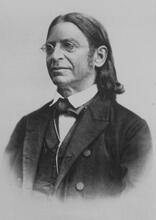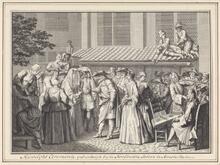German-Jewish Pietists: Attitudes towards Women
Despite their small numbers, the introspective and penitential religious outlook of the German-Jewish Piestists, or Hasidei Ashkenaz, had a significant and lasting impact on European Jewry, including in their representations of women. Written by men and intended for a male audience, the Piestists’ writings heighten the profound ambivalence towards women that is inherent in rabbinic tradition. They portray women in general as flawed beings who are amenable potential partners in a range of imagined indiscretions. Conversely, however, the German-Jewish Pietists praised the treasured and irreproachable women of their own family circles. Thus, the authors are torn: they are caught in the contradictions of their constructed characterizations of women.
Introduction
This article discusses representations of women in the writings of the German-Jewish Pietists (Hasidei Ashkenaz), circles of scholars and mystics who were active mainly in the Rhineland from the mid-twelfth through the thirteenth century. Despite their small numbers, the introspective and penitential religious outlook of the Hasidei Ashkenaz had a significant and lasting impact on European Jewry. The most influential group, which originated in Mainz, was founded by R. Samuel ben Kalonymus of Speyer (b. 1115); he was succeeded by his son, known as R. Judah the Pious (he-hasid; 1140-1217). R. Eleazar ben Judah (ben Kalonymus) of Worms (ca. 1165- ca. 1238), known as the Roke’ah, Judah’s student and relative, was the most prolific writer of this circle; his works include a legal text, Sefer ha-Rokeah (Book of the Perfumer), a poetic elegy for his wife Dulcea and daughters, and a number of esoteric writings.
The best-known literary production of this pietistic community is Sefer Hasidim (Book of the Pious), an anthology consisting of more than a thousand discrete passages on a range of subjects. Beyond the insights it offers into its authors’ ethical and spiritual preoccupations, Sefer Hasidim is an important witness to many aspects of Jewish daily life in medieval Germany and northern France (a region that Jews referred to as Ashkenaz). Moreover, its contents reveal various influences from contemporary Christianity and the folk culture of the Rhineland region. The German-Jewish Pietists were deeply affected by the tragic murders and forced conversions suffered by Rhineland Jewish communities during the 1096 First Crusade. Their writings exhibit a post-traumatic covenantal theology that interpreted the violent actions of the crusaders as a form of merited divine punishment. Afflicted with a sense of crushing guilt, the Hasidei Ashkenaz sought forgiveness for sins whose commission, they believed, was certain, even if their actual substance was mysterious. This consciousness of culpability underlies a pronounced emphasis on avoiding transgressions of both mind and body and a roster of acts of atonement to be undertaken when temptation overtook prudence.
Written by men and intended for a male audience, the Pietists’ writings heighten the profound ambivalence towards women that is inherent in rabbinic tradition. Building on rabbinic foundations, the Hasidei Ashkenaz portray the niddah, the menstruating woman, as a source of peril, and they take for granted, as did most others in their larger milieu, that some women, including Jews, were involved in witchcraft (SefHasB §§680,1538; SefHasP §§1466-67). The Pietists also amplify rabbinic representations of women as weak-minded and seductive; they portray women in general as flawed beings who are amenable potential partners in a range of imagined indiscretions. In line with their mystical yearnings, they also warn against women as potential distractions from the devotion that should exist between man and God. It seems likely that medieval Christian convictions of the inherently carnal nature of human beings, the negative role of woman in man’s fall, and the preferable option of celibacy for those who were spiritually capable of it also played a significant role in the intensified moral uneasiness of the Hasidei Ashkenaz, enhancing their profound alienation from what they perceived as a world of unending potential pitfalls (Baskin, “From Separation to Displacement”).
Conversely, however, the German-Jewish Pietists praised the treasured and irreproachable women of their own family circles. Indeed, some of these women are represented in Sefer Hasidim and related documents as surpassing their husbands in piety and righteousness. An exemplary woman of this milieu, like Dulcea, the wife of R. Eleazar ben Judah of Worms, not only played religious roles such as leading women's prayers in the synagogue, but also supported her household economically so that her husband could devote himself to study and teaching (Baskin, “Dolce of Worms”). Thus, the authors of Sefer Hasidim are torn: they are caught in the contradiction that women, even the most pious and God-fearing, simply by virtue of their gender, have the potential, however unwittingly, to tempt a man to sin or sinful thoughts and to distract him from what should be his focus on serving and seeking God.
The Niddah
Emphasis on the laws pertaining to the niddah (menstruating woman) constituted a central motif in the construction of women and marital life in Ashkenaz. Women’s punctilious observance of the mandates pertaining to the menstruating wife (hilkhoth niddah) enabled their husbands to remain ritually pure. The idea that being in a state of ritual impurity could have a spiritual or psychological impact on women themselves was rarely considered. (For one exception, see SefHasB §1148, where women’s monthly cycles are likened to the waxing and waning of the moon and women are said to feel isolated during their states of niddah.) When Eleazar ben Judah enumerated the appropriate expressions of penance for those who transgressed the prohibition against contact between a man and a niddah in his Sefer Ha-Rokeah, he assumed that these acts of atonement, which included extensive fasting, lashing, and immersion in icy water, applied only to men (Hilkhot Teshuvah §14, 27).
Dangers associated with the niddah are mentioned in various rabbinic writings (BT Pesahim 111a; BT Shabbat 110a; Baskin, Midrashic Women, 27-29). However, the Pietists’ unusually severe approach was likely influenced by a text known as the Baraita de-Niddah, probably composed in Palestine or Italy in the later part of the first millennium CE. Baraita de-Niddah goes beyond talmudic literature in its emphasis on the threats to male ritual purity posed by the niddah. In Sefer ha-Rokeah, R. Eleazar directly echoes the Baraita de Niddah in his declaration that a niddah may not wear eye makeup or jewelry or cook or bake for her husband: “she will not dance, she will not prepare the bed, and she will not pour water from one vessel to another, because she is in a state of impurity and she can transmit impurity. And she is forbidden to enter a synagogue until she has immersed in water.” He notes that the saliva of a niddah transmits impurity and goes on to say that a niddah who is not careful in her practice produces blemishes in her children, even to the twentieth generation, and causes her husband to lose the world to come (Hilkhot Niddah §318, 205-206; Baskin, “Women and Ritual Immersion,” 140).
While the Hasidei Ashkenaz aspired to a degree of personal practice stricter than the norm, their pietism, particularly as formulated by R. Eleazar in Sefer ha-Rokeah, had a lasting impact on Ashkenazic religious and social life. Thus, their insistence on the dangerous propensities of the niddah was highly influential in establishing and preserving exclusionary customs among European Jews in succeeding centuries; the niddah was encouraged to avoid the sacred space of the synagogue in many Jewish communities in Christian Europe well into the early modern period, even though there was no halakhic warrant for this practice.
Woman as Potential Temptation
The dangers of male sexual desire also play a part in the ambivalence of the Hasidei Ashkenaz toward women. A lengthy statement in Sefer Hasidim emphasizes that the pious man must avoid temptation: “He does not look at the countenances of women: especially so among other men where women are customarily seen, for example, if he has been in the wedding hall where the women were garbed in choicest ornaments and all were gazing . . . ” The passage goes on to warn that, “Whenever he meets a woman, whether single or married, whether a gentile woman or Jewish, whether she be of age or a minor,” he should not look at her, for “nothing interposes better against desire than closing one’s eyes . . .” (SefHasB §9; partial version in SefHasP §978). Sefer Hasidim recommends that men limit contacts with their wives except during marital intimacy, advising, “Each one who wishes to return in repentance and achieve a status of piety. . . let him forsake . . . converse with his wife except while making love . . . and let this not be a burden upon him because of his love for his Creator” (SefHasB §29; SefHasP §§984, 989. The precept that one should refrain as much as possible from converse with one’s wife except during sexual intercourse appears in BT Hagigah 5b.)
However, maintaining too great a distance from one’s wife could also lead to sin, and the Pietists emphasize that happy marital relations are an essential fence against the possibility of sexual temptation elsewhere. As R. Eleazar counseled, “One should avoid looking at other women and have sexual relations with one’s wife with the greatest passion because she guards him from sin,” and “since she is his intimate partner he should display affection and love toward her” (Sefer ha-Rokeah ha-Gadol, Hilkhot Teshuvah, §§20, 30, and §§14, 27).
Given this emphasis on harmonious marital relations as a fence against transgression, it is not surprising to find frequent reminders in pietistic sources that women must be as expeditious as possible in immersing in the ritual bath (mikveh) at the end of their state of niddah in order to maintain domestic accord (Baskin, “Women and Ritual Immersion,” 138-142). A discussion on this topic from the circle of the Hasidei Ashkenaz, ostensibly about whether or not a father should teach his daughters to write, conflates concerns about a woman’s timely immersion with questions about the acceptable limits of female education and the omnipresence of sexual snares for the unwary. The father is concerned that if his daughters are illiterate, they will ask men from outside their family to write their receipts for pledges when they lend money. This propinquity may lead them, or the men they consult, into sin or thoughts of sin. Thus, the father teaches them to write “receipts for pledges, and he taught them that whenever it was time for their immersion they should not delay, for when her husband desires her she should be ready so that he will not engage in bad thoughts and so that she will preserve him from all such fantasies” (Hebrew Ms. 1566, Bodleian Library Oxford, p. 178a, published in Joseph Dan, Iyunim b'sifrut hasidut ashkenaz [Ramat-Gan, Israel, 1975], 140). As this passage makes clear, teaching daughters to write and teaching them not to delay their ritual immersions are directly related. Both are strategies to prevent inappropriate thoughts or actions that might be prompted by encounters with women outside the marital dyad.
A passage in Sefer Hasidim reveals similar sentiments and also implies that a wife’s refusal to immerse as expeditiously as permissible could constitute a form of marital blackmail. Thus, fathers are advised to instruct their daughters, prior to marriage, never to delay the time of immersion in the mikveh: “She must never say to her husband, ‘I will not immerse unless you give me such and such a sum of money or a certain object.’ Rather, if the two of them devote their thoughts to heaven when they are intimate, their sons will be good” (SefHasB §506).
Woman as Potential Diversion
Emphasizing marriage as the licit location for sexual expression was both essential and problematic for the German-Jewish Pietists. Although the authors of Sefer Hasidim placed great importance on happy spousal relations as a barrier against the appeal of forbidden sexual partners, a husband’s affection for his wife always had to be secondary to his yearning for the divine. While celibacy was an option for Christians who wished to focus on a spiritual life, avoiding marriage was virtually impossible for a Jewish male, given Judaism’s emphasis on a man’s imperative to procreate (see Infertile Wife in Rabbinic Judaism). Rather, the Pietist is counselled to channel his sexual desire and performance to a divine purpose. As one passage in Sefer Hasidim states, however great a man’s love for his wife, “greater than this should be the love of the Creator in the hearts of those who love Him and they should be absorbed in it constantly, as we were commanded, ‘with all your heart, with all your soul’ (Deut 6:5)” (SefHasB §14). The Pietist’s desire for separation from the corruption of the material world and his wish to channel the pleasures of human sexuality into his devotion to God are built, perforce, upon the displacement and objectification of women.
Conclusion
The Hasidei Ashkenaz were convinced of their own sinfulness and of the carnality of those around them. Women, in particular, presented a variety of impediments to righteousness since they constituted a physical threat to male ritual purity and their inherent seductiveness made them objects of male sexual desire. The solution was to channel these yearnings into marital sexuality while otherwise limiting contact with women as much as possible. However, strong marital ties were also problematic, since they could distract men from a primary focus on the divine. Moreover, the conundrum was further complicated for the Hasidei Ashkenaz by the reality that many women of their circle were wholly praiseworthy. When R. Eleazar wrote an encomium to his murdered wife, Dulcea, he turned to Prov 31:1-10, the praise of the “woman of valor” (eshet hayyil). This enumeration of female virtues provided him with the language and framework through which to praise his beloved partner beyond the confines of his existential reality (Baskin, “Dolce”; Baumgarten, Biblical Women, 173-176).
Baskin, Judith R. “Dolce of Worms: The Lives and Deaths of an Exemplary Medieval Jewish Woman and her Daughters.” In Judaism in Practice: From the Middle Ages through the Early Modern Period, edited by Lawrence Fine, 429-437. Princeton, NJ: Princeton University Press, 2001.
Baskin, Judith R. “From Separation to Displacement: The Problem of Women in Sefer Hasidim.” Association for Jewish Studies Review 19, no.1 (1994): 1-18.
Baskin, Judith R. “Male Piety, Female Bodies: Men, Women, and Ritual Immersion in Medieval Ashkenaz.” Studies in Medieval Halakhah. Journal of Jewish Law 17 (2007): 11-30.
Baskin, Judith R. Midrashic Women: Formations of the Feminine in Rabbinic Literature. Hanover, NH: Brandeis University Press, 2002.
Baskin, Judith R. “Representations of Biblical Women in the Writings of the Hasidei Ashkenaz,” In The Bible and Women. Volume 4:2: The Jewish Middle Ages. Ed. Carol Bakhos and Gerhard Langer, 153–170. Atlanta: Society of Biblical Literature and Leiden: Brill, 2022.
Baskin, Judith R. “Women and Ritual Immersion in Medieval Ashkenaz: The Sexual Politics of Piety.” In Judaism in Practice: From the Middle Ages through the Early Modern Period, edited by Lawrence Fine, 131-142. Princeton, NJ: Princeton University Press, 2001.
Baumgarten, Elisheva, “Gender and Daily Life in Jewish Communities.” In The Oxford Handbook of Women and Gender in Medieval Europe, edited by Judith Bennett and Ruth Mazo Karras, 213-228. Oxford: Oxford University Press, 2013.
Baumgarten, Elisheva. Practicing Piety in Medieval Ashkenaz: Men, Women, and Everyday Religious Observance. Philadelphia: University of Pennsylvania Press, 2014.
Baumgarten, Elisheva. Biblical Women and Jewish Daily Life in the Middle Ages. Philadelphia: University of Pennsylvania Press, 2022.
Baumgarten, Elisheva. “Who Was a Ḥasid or Ḥasidah in Medieval Ashkenaz? Reassessing the Social Implications of a Term.” In Sefer Ḥasidim -- Book, Context, and Afterlife. Studies in Honor of Ivan G. Marcus. Jewish History 34, nos. 1-3 (2021):125-154.
Eleazar ben Judah of Worms. Sefer ha-Rokeah ha-Gadol, Jerusalem: Otzar Ha-Poskim, 1966.
Grossman, Avraham. Pious and Rebellious: Jewish Women in Medieval Europe. Translated by Jonathan Chipman. Waltham, MA: Brandeis University Press, 2004.
Marcus, Ivan G. “Sefer Hasidim” and the Ashkenazic Book in Medieval Europe. Philadelphia: University of Pennsylvania Press, 2018.
Sefer Hasidim. Citations to Sefer Hasidim are from Sefer Hasidim, ed. Judah Wistinetzki, with an introduction by Jacob Freimann (Frankfurt am Main: M. A. Ṿahrmann, 1924), based on an Ashkenazic manuscript ca. 1300, now in Parma (SefHasP); and Sefer Hasidim, ed. Reuven Margoliot (Jerusalem: Mossad Ha-Rav Kook, 1957), an edition of the second printed version (1580) of a manuscript now in Bologna (SefHasB). The Princeton University Sefer Hasidim Database (PUSHD) has created an electronic database including all known manuscript and printed versions of this work (https://etc.princeton.e







